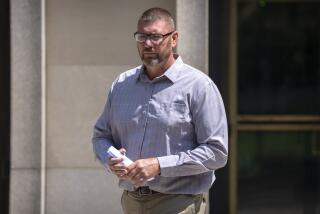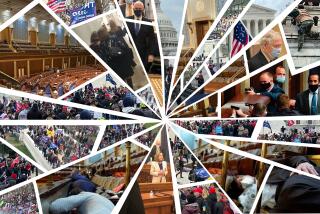Deadly Shooting Turns a Tragic Spotlight on Work of Capitol Police
- Share via
WASHINGTON — U.S. Capitol Police Chief Gary L. Abrecht says it almost in a whisper, as if voicing it softly can somehow soften the blow: “Thirteen seconds, that’s right. Just 13 seconds.”
In 13 seconds on July 24, a gunman “irrevocably changed” the U.S. Capitol Police, said Abrecht, who until recently could not bring himself to discuss the day two longtime officers were shot to death inside the U.S. Capitol.
Russell Eugene Weston Jr. has been charged with the killings of Det. John M. Gibson and Officer Jacob J. Chestnut Jr.
Gibson and Chestnut, both 18-year veterans, were the first officers to be killed while standing watch over Congress. Americans from across the country mourned their deaths, piling mounds of flowers on the Capitol steps and sending cards and letters to their colleagues and families. In the wake of the tragedy, the department picked up other bittersweet rewards: national recognition and a sense of appreciation for the work they do.
“We are here to serve Congress, not to attract attention to ourselves,” said Abrecht, who has been on the Capitol force for 6 1/2 years after spending 23 years with the District of Columbia Police Department. “We train our officers to stay out of the limelight as part of our ethics. It was a little-known department nationally, and that is certainly gone. But this tragic incident has given our officers a new sense of self-worth, and I do appreciate that.”
Five months after the shootings, Abrecht said, his department is finally healing, thanks “to the little things.” Schoolchildren still send condolence cards. The Senate recording studio gave everyone in the department a videotape of the officers’ memorial services. Members of Congress and their staffs no longer treat officers simply as security guards.
“Our people have just been taken aback by all of the expressions of support,” Abrecht said. “The outpouring we saw from other law enforcement agencies, from people who have called or written, and the tremendous change we’ve seen in the relationship we have with the congressional staff has been very humbling. It’s those little gestures that mean the most.”
Abrecht and his staff are still analyzing the horrifying 13 seconds after the gunman walked in the Document Room door on the House side of the Capitol on a warm Friday at 3:40 p.m. The review will not be completed until Weston’s case goes to trial.
“Is there anything we could have done to mitigate the situation, not from the point of view of the officers, but did we as management do everything we could to protect the officers?” Abrecht said.
A security videotape provided a graphic look into most of the tragedy, according to investigators who have seen it.
Sources said the videotape shows that Weston, the man charged in the shootings, walked through a metal detector, setting it off, then pointed his gun at the back of Chestnut’s head and fired before the officer had a chance to respond. As Chestnut collapsed and congressional aides and tourists scrambled for cover, Officer Douglas P. McMillan fired at the gunman several times, striking a tourist in the face in the cross-fire.
The gunman ran past them, following an unidentified female bystander who was running for cover toward a door leading to the suite of Rep. Tom DeLay (R-Texas). Inside, Gibson yelled for DeLay and his aides to protect themselves under desks and other furniture. But before Gibson could draw his gun, the woman, with the gunman behind her, appeared in the doorway. Gibson pushed her to safety, and the gunman shot him once in the chest. Gibson then grabbed his own gun and shot the suspect in the legs.
House and Senate negotiators agreed to authorize $100 million in public funds to create a Capitol visitor’s center, an underground tourist entrance and security complex.
Abrecht said the shootings put his 1,050 sworn officers on a heightened sense of alert.
“To the extent that there was a certain amount of complacency, an element of thinking that we’re safer than other police departments, now it is clear,” Abrecht said. “When you’re talking about a high-visibility target like the Capitol, it can happen to you just like to any other police officer in the country.”
More to Read
Sign up for Essential California
The most important California stories and recommendations in your inbox every morning.
You may occasionally receive promotional content from the Los Angeles Times.










